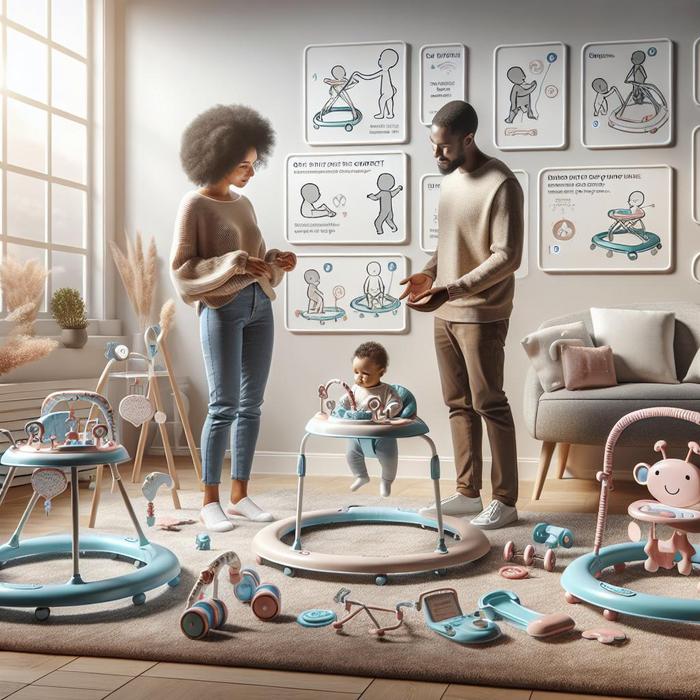Exploring Baby Walker Safety: A Crucial Consideration for Parenting
As the joy of seeing your little one take their first steps comes closer, you might consider buying a baby walker to aid their self-exploration. While these walkers can provide an outlet for budding curiosity, it is essential to understand how to ensure baby walker safety to prevent accidents and enhance mobility. As we navigate this topic, we will delve into the science behind walker safety, essential tips for preventing accidents, and guidance for choosing the right walker.
The Science Behind Walker Safety
Contrary to commonplace belief, baby walkers might not always accelerate your baby’s walk-learning process. Some studies suggest that these walkers might even lead to delayed motor development and a higher risk of accidents. A post on Reddit’s ScienceBasedParenting community discusses the pros and cons of baby walkers in a comprehensive manner.
A report by the Harvard Health Blog titled Parents, don’t use a baby walker reiterates this point, warning against potential risks associated with walker usage. However, if you choose to use a walker, ensuring your child’s safety should be paramount. We share some tips for that below.
Preventing Accidents: What to Keep in Mind
• Supervise at all times: Never leave your baby unattended in the walker. Active supervision is the best way to prevent accidents.
• Safe play space: Make sure the play area is free of stairs and sharp objects. This also includes heaters or open fires, which might pose a burn risk.
• Block access to risky areas: Use safety gates to block access to kitchens and bathrooms.
• Regular checks: Regularly inspect the walker for damage. If found, repair it immediately or replace the entire unit.
Our post on car seat safety offers more insights on child safety precautions that you might find helpful!
Choosing the Right Walker: Enhancing Mobility Safely
The right baby walker should offer safety while enhancing your child’s mobility. Here are some features to consider:
• Friction strips: These will help halt the walker at the edge of a step.
• Width: A walker should be wide enough to not fit through a standard-sized door.
• Stability: A stable design helps prevent tipping over. Walkers with a wider base are often more stable.
• Adjustable height: This allows the walker to grow with your child, ensuring prolonged usability.
Remember, safety is a priority, but so is comfort — a comfortable baby is a happy baby. Therefore, the walker you choose should also provide a comfortable seat and promote proper posture.
Practice Makes Perfect: A Safety-First Approach
Ultimately, there can be a bit of a learning curve when it comes to securing your child in a walker. You may find it helpful to revisit this post or consult other resources from our blog as your child grows and their needs change. Remember, the goal is to maximize your child’s fun and exploration, while minimizing any potential risk of injury.
Helpful Tips and Tricks for Baby Walker Safety
While we have covered the fundamental aspects of babies’ safety while using walkers, there is much more to discuss. Parents often ask about toys for walkers, how to improve baby’s balance, when to start and stop using a baby walker. Every child is different, but there are general suggestions available based on the common milestones children reach. Dive deeper with us as we explore more aspects of baby walker safety in the following sections.
Walkers and Toys: The Balancing Act
Toys can stimulate your child’s curiosity and learning while in a walker. However, not every toy is safe for use in a walker. According to TheBump, the key is to choose small, light, and non-chokable toys. Furthermore, avoid toys with strings or cords, as they can become a strangulation hazard. Therefore, balancing fun and safety becomes essential when introducing toys to your baby’s walker experience.
Fostering Balance and Motor Skills
While a walker offers support, your child’s ability to balance independently and develop motor skills is vital. You could supplement walker use with floor playtime, encouraging your little one to crawl, sit up, or pull themselves up on furniture. According to KidsFirstPediatrics, these activities can promote muscle strength and coordination, crucial for walking on their own.
When to Start and When to Stop Using a Walker
According to HealthyChildren, you should only consider using a walker once your baby can sit up without support, usually around 6 months. You should stop using the walker once your child begins to walk unaided or if they can climb out of it, as this can lead to serious accidents.
Walker Alternatives: Exploring Safe Options
If you’re hesitant about using a traditional baby walker, consider safer alternatives. A seated activity center, also known as an “exersaucer,” allows the child to bounce and spin while playing with attached toys. Stationary walkers, where the wheels are locked, and push-along walkers, where the child pushes it from behind, are other options.
As per PregnancyBirthBaby, these options can offer the same fun activity-filled environment as a baby walker, with the added confidence that your baby won’t scoot away and into potential hazards.
Your Baby Walker Safety Journey: A Continuous Learning Process
Baby walker safety is a comprehensive topic, touching upon your child’s physical development, your home environment, and choosing appropriate equipment. Remember, safety comes first and foremost, and it’s always better to be overly cautious when it comes to your little one’s well-being.
Every child is unique, and what works for one may not work for others. Stay open to new information, monitor your child’s progress and adapt along the way. Most importantly, the entire experience should be filled with joy and discovery for both you and your child.






